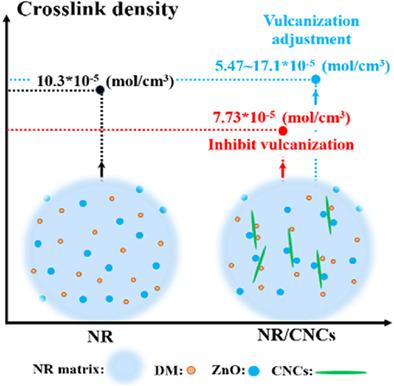当前位置:
X-MOL 学术
›
J. Polym. Sci.
›
论文详情
Our official English website, www.x-mol.net, welcomes your feedback! (Note: you will need to create a separate account there.)
Effects of cellulose nanocrystals on the vulcanization of natural rubber/cellulose nanocrystals nanocomposite and corresponding regulating strategies
Journal of Polymer Science ( IF 3.4 ) Pub Date : 2021-09-08 , DOI: 10.1002/pol.20210603 Jie Hu 1 , Fan Yang 1 , Ke Liu 1 , Zhengqing Kong 1 , Jinli Qin 1 , Yongxin Duan 1 , Jianming Zhang 1
Journal of Polymer Science ( IF 3.4 ) Pub Date : 2021-09-08 , DOI: 10.1002/pol.20210603 Jie Hu 1 , Fan Yang 1 , Ke Liu 1 , Zhengqing Kong 1 , Jinli Qin 1 , Yongxin Duan 1 , Jianming Zhang 1
Affiliation

|
Vulcanization is a vital process in rubber processing, it endows rubber with valuable physical and mechanical properties, making rubber a widely used engineering material. In addition to vulcanization agent, reinforcing fillers play a non-ignorable influence on the vulcanization of rubber nanocomposites. Herein, the effects of cellulose nanocrystals (CNCs) on the vulcanization of natural rubber (NR)/CNCs nanocomposite was studied. It was found that even though the addition of CNCs can effectively improve the dispersion of ZnO in NR matrix, the vulcanization of NR was inhibited. This may be attributed to the CNCs' adsorption of vulcanizing agents (DM, ZnO) and the acidic chemical environment on the surface of CNCs. In order to improve the vulcanization properties of NR/CNCs nanocomposite, tetramethyldithiochloram (TMTD) and triethanolamine (TEOA) were used as a combination accelerator and curing activator, respectively, and polyethylene glycol (PEG) was introduced to screen hydroxyl groups on the surface of CNCs to prohibit the CNCs' adsorption of vulcanizing agents. The results indicate that TMTD and TEOA effectively improved the vulcanization rate of NR/CNCs nanocomposite and increased the crosslink density by an order of magnitude. Subsequently, the tensile strength, tear strength, and so forth. of NR/CNCs nanocomposite were significantly improved. However, PEG hardly help to improve the vulcanization properties of NR/CNCs nanocomposite. In addition, the control samples without CNCs were prepared and characterized, the comparation between NR and NR/CNCs nanocomposite shows that the synergistic effect of crosslink density and CNCs' reinforcement more effectively improve mechanical properties of NR. This work not only elucidates the inhibiting mechanisms of CNCs on the vulcanization of NR, but also provides practical strategies for improving the vulcanization and properties of NR/CNCs nanocomposite. It may accelerate the application of CNCs as rubber reinforcing filler.
中文翻译:

纤维素纳米晶对天然橡胶/纤维素纳米晶纳米复合材料硫化的影响及相应的调控策略
硫化是橡胶加工中的重要工序,它赋予橡胶宝贵的物理和机械性能,使橡胶成为一种广泛使用的工程材料。除了硫化剂外,补强填料对橡胶纳米复合材料的硫化也有着不可忽视的影响。在此,研究了纤维素纳米晶体 (CNCs) 对天然橡胶 (NR)/CNCs 纳米复合材料硫化的影响。结果表明,尽管CNCs的加入可以有效提高ZnO在NR基体中的分散性,但NR的硫化受到抑制。这可能归因于 CNCs 对硫化剂(DM、ZnO)的吸附以及 CNCs 表面的酸性化学环境。为了提高NR/CNCs纳米复合材料的硫化性能,分别使用四甲基二硫草胺(TMTD)和三乙醇胺(TEOA)作为组合促进剂和硫化活化剂,并引入聚乙二醇(PEG)来筛选CNCs表面的羟基以阻止CNCs对硫化剂的吸附。结果表明,TMTD和TEOA有效提高了NR/CNCs纳米复合材料的硫化速率,使交联密度提高了一个数量级。随后是拉伸强度、撕裂强度等。NR/CNCs 纳米复合材料的显着改善。然而,PEG对提高NR/CNCs纳米复合材料的硫化性能几乎没有帮助。此外,还制备并表征了不含 CNC 的对照样品,NR与NR/CNCs纳米复合材料的比较表明,交联密度和CNCs增强的协同作用更有效地提高了NR的力学性能。该工作不仅阐明了CNCs对NR硫化的抑制机制,而且为提高NR/CNCs纳米复合材料的硫化性能和性能提供了实用的策略。它可能会加速CNCs作为橡胶增强填料的应用。
更新日期:2021-09-08
中文翻译:

纤维素纳米晶对天然橡胶/纤维素纳米晶纳米复合材料硫化的影响及相应的调控策略
硫化是橡胶加工中的重要工序,它赋予橡胶宝贵的物理和机械性能,使橡胶成为一种广泛使用的工程材料。除了硫化剂外,补强填料对橡胶纳米复合材料的硫化也有着不可忽视的影响。在此,研究了纤维素纳米晶体 (CNCs) 对天然橡胶 (NR)/CNCs 纳米复合材料硫化的影响。结果表明,尽管CNCs的加入可以有效提高ZnO在NR基体中的分散性,但NR的硫化受到抑制。这可能归因于 CNCs 对硫化剂(DM、ZnO)的吸附以及 CNCs 表面的酸性化学环境。为了提高NR/CNCs纳米复合材料的硫化性能,分别使用四甲基二硫草胺(TMTD)和三乙醇胺(TEOA)作为组合促进剂和硫化活化剂,并引入聚乙二醇(PEG)来筛选CNCs表面的羟基以阻止CNCs对硫化剂的吸附。结果表明,TMTD和TEOA有效提高了NR/CNCs纳米复合材料的硫化速率,使交联密度提高了一个数量级。随后是拉伸强度、撕裂强度等。NR/CNCs 纳米复合材料的显着改善。然而,PEG对提高NR/CNCs纳米复合材料的硫化性能几乎没有帮助。此外,还制备并表征了不含 CNC 的对照样品,NR与NR/CNCs纳米复合材料的比较表明,交联密度和CNCs增强的协同作用更有效地提高了NR的力学性能。该工作不仅阐明了CNCs对NR硫化的抑制机制,而且为提高NR/CNCs纳米复合材料的硫化性能和性能提供了实用的策略。它可能会加速CNCs作为橡胶增强填料的应用。



























 京公网安备 11010802027423号
京公网安备 11010802027423号